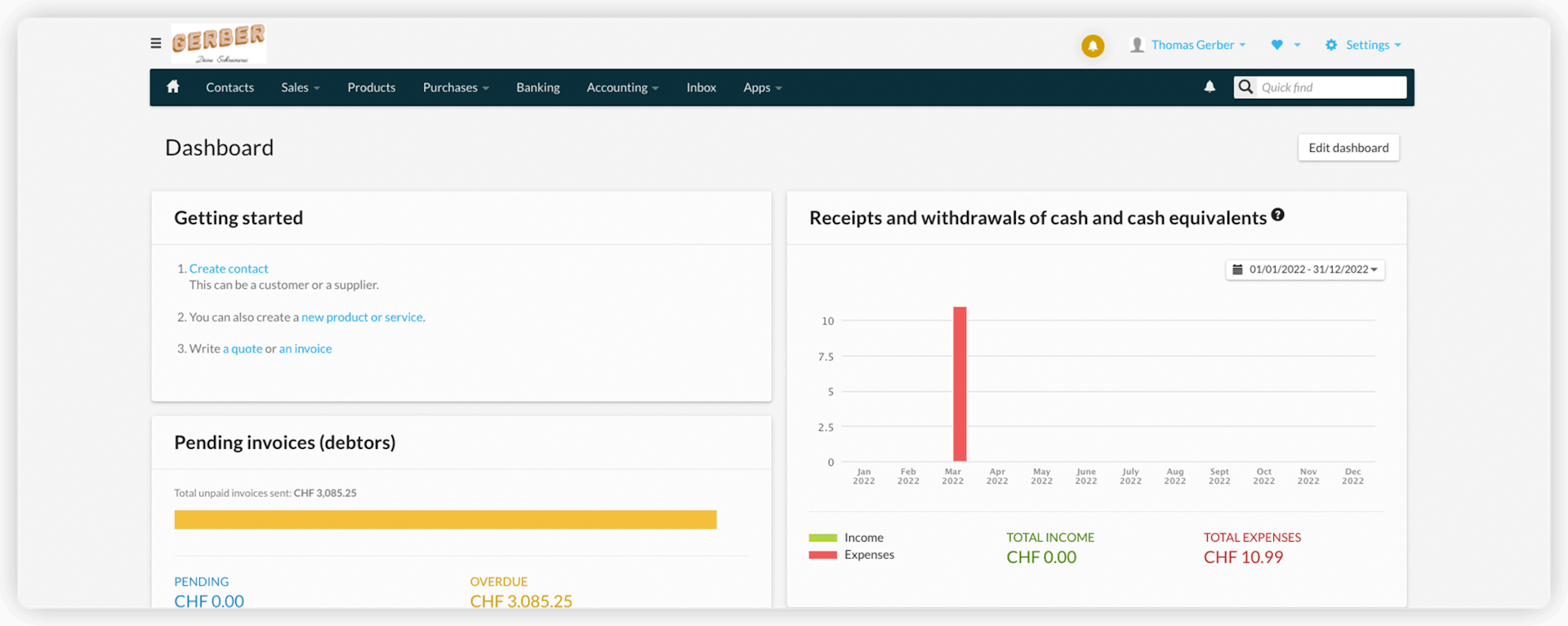Every company in Switzerland is obliged to maintain accounts. This also applies to freelancers and sole traders, for example. The good news is that small companies are allowed to keep simplified accounts by means of a statement of income and expenses, which is also known as cash-based accounting. You will find the most important information about it here, as well as an Excel template for downloading.

What is single-entry bookkeeping?
In single-entry bookkeeping – also known as cash-based accounting – each item of income and each expense only has to be recorded once. Self-employed people or sole traders with an annual turnover of less than CHF 100,000 can use this simplified form of accounting. If their turnover is between CHF 100,000 and 500,000, then they also have to do VAT statements.
Single-entry bookkeeping in detail
At the beginning of 2013, the new financial reporting law (Swiss Code of Obligations) was introduced in Switzerland. Since then, small businesses have no longer been required to maintain double-entry accounts. Instead, single-entry bookkeeping is sufficient. It is also called cash-based accounting. With this simplified form of bookkeeping, you only have to cite the financial position of your company in addition to income and expenses.

The difference between single- and double-entry bookkeeping
In single-entry bookkeeping, you only record each item of income or expense once. The income and expenses need only be listed after the date on which the amount was received or issued (cash-based method). The calculation of income versus expenditure can only be used to determine whether a profit or loss has been incurred.
In double-entry bookkeeping, on the other hand, you must record each item of income or expense twice. On the one side, you record the account in which the movement took place (the account), and, on the other, what the money was used for (the contra account). You will find a simple explanation with examples in our post on double-entry bookkeeping.
Legal requirements for single-entry bookkeeping in Switzerland
Single-entry bookkeeping is generally a relief for small businesses. Nevertheless, the principles of proper accounting (GOB) under Art. 957a (2) of the Swiss Code of Obligations (OR) must be adhered to, including:
- "the complete, truthful and systematic recording of business transactions and facts";
- "proof of receipts for the individual posted transactions";
- "clarity";
- "appropriateness with a view to the nature and size of the company"; and
- "verifiability".
Therefore, even with single-entry bookkeeping, you must ensure that all business transactions are properly documented in a comprehensible manner and in full, with supporting documents, so that an expert third party can quickly gain an overview. This includes, among other things, the time of the business transaction, the name of the service provider or recipient, and the reason for payment.
Who is allowed to use single-entry bookkeeping?
If your annual turnover is less than CHF 100,000, you are generally allowed to make use of single-entry bookkeeping in Switzerland.
Sole traders with an annual turnover of less than CHF 100,000
If you are a sole trader with an annual turnover of less than CHF 100,000, you are allowed to use single-entry bookkeeping. In addition, you are not obliged to account for VAT.
Sole traders with an annual turnover of CHF 100,000 to 500,000
If you are a sole trader with a turnover of CHF 100,000 to 500,000, you are still allowed to use the simplified form of accounting, but, from now on, will be subject to VAT. You can choose between simple or effective VAT accounting.
How do I do single-entry bookkeeping?
You have several options for how to maintain your single-entry accounts:
Automated with accounting software
Even if you are only obliged to keep single-entry accounts, you can maintain your statement of income vs expenditures using an accounting program for small business owners.
Whether software can be of benefit to you primarily depends on how much time you want to spend on your accounting. Do you write and receive numerous invoices and spend more time than you want on accounting and processing receipts? Then it definitely makes sense to automate many of your work steps with the help of software.
Manually with Excel
From a legal point of view, an Excel template is sufficient for maintaining your single-entry accounts. Note, however, that keeping accounts manually increases the susceptibility to errors. Therefore, always check your documents very carefully.
Important tips for cash-based accounting
Whether automated or manual, the following tips apply regardless of the method you choose when creating your statement of income and expenses:
- Record all income, without exception.
- Also record all business expenses as far as possible.
- Enter at least the following details for each entry or disbursal:
- Supporting document number
- Date
- The amount of income or expenditure in CHF
- Description (service recipient or service provider and reason for payment)
An example of a statement of income and expenses
Using a simplified example, we show what a statement of income and expenses can look like (click for a larger view):
Single-entry bookkeeping template
To make manual single-entry bookkeeping easier, we are offering you an Excel template here for downloading – separated by income and expenditure and equipped with all the columns and rows required for your statement of income and expenses.
Accounting in bexio
bexio is the perfect tool for SME administration: automate your accounting, create quotations and invoices in just a few clicks, and manage your contacts – all in one piece of intuitive, online software that is perfectly tailored to the needs of SMEs, start-ups and the self-employed. Learn more about bexio's features.
You are also welcome to test bexio without obligation. To do this, simply enter your email address and let yourself be impressed by bexio for 30 days – free of charge and without obligation.

Frequently asked questions about single-entry bookkeeping
Single-entry bookkeeping, also known as cash-based accounting, offers both advantages and disadvantages:
Benefits of single-entry bookkeeping:
- Simplicity: Compared to double-entry bookkeeping, single-entry bookkeeping is easier to understand and implement. It does not require transactions to be entered twice.
- Time and cost savings: Because single-entry bookkeeping is less complex, entrepreneurs spend less time recording transactions, thereby saving money.
- Ideal for small businesses: For small businesses or the self-employed for whom cash flow is manageable, single-entry bookkeeping provides a practical framework for managing their finances.
Disadvantages of single-entry bookkeeping:
- Lack of detail: Single-entry bookkeeping does not provide the same level of detail as double-entry bookkeeping. It, therefore, cannot provide the same amount of information about a company's financial situation.
- Less control: Because single-entry bookkeeping does not provide the same level of control and verifiability as double-entry bookkeeping, it can be more difficult to detect errors or inconsistencies.
- Not suitable for larger companies: For larger companies that have more complex transactions, single-entry bookkeeping is usually not sufficient for managing all financial information.
The choice between single- and double-entry bookkeeping depends on many factors – including the size of the company, the number of transactions and their complexity, and, of course, legal requirements. Therefore, it is important to consider the specific needs and objectives of the company before making a decision. Even if you start small, it's worth looking to the future: for example, are you planning to expand in the foreseeable future? Then it would be advisable to use double-entry bookkeeping from the outset.
The identification and correction of errors in single-entry bookkeeping makes a significant contribution to correct financial reporting. Here are some steps that may help you with this:
- Regular reviews: Make a habit of reviewing your books on a regular basis. This can be done weekly, monthly or quarterly, depending on the size and complexity of your company.
- Comparison with bank statements: Regularly compare your accounting documents with your bank statements. Differences between the two can indicate errors in your bookkeeping.
- Third-party review: It may be helpful to have your books reviewed by an external accountant or trustee. A trained eye can sometimes find mistakes that you may have overlooked.
- Use of software: Accounting software can also help identify and correct errors or prevent them from arising in the first place thanks to automated processes.
Test out bexio now for 30 days free of charge and with no obligation
Test all the features of bexio, the simple business software for your SME administration.





